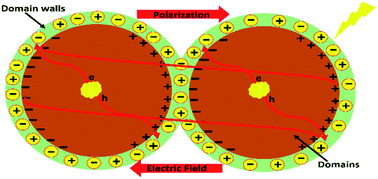当前位置:
X-MOL 学术
›
J. Mater. Chem. A
›
论文详情
Our official English website, www.x-mol.net, welcomes your feedback! (Note: you will need to create a separate account there.)
Exploration of the intrinsic factors limiting the photocurrent density in ferroelectric BiFeO3 thin film
Journal of Materials Chemistry A ( IF 11.9 ) Pub Date : 2020/03/21 , DOI: 10.1039/d0ta00955e Jafar Hussain Shah 1, 2, 3, 4, 5 , Hengyun Ye 6, 7, 8, 9 , Yong Liu 1, 2, 3, 4, 5 , Ahmed Mahmoud Idris 1, 2, 3, 4, 5 , Anum Shahid Malik 1, 2, 3, 4, 5 , Yi Zhang 6, 7, 8, 9 , Hongxian Han 1, 2, 3, 4, 5 , Can Li 1, 2, 3, 4, 5
Journal of Materials Chemistry A ( IF 11.9 ) Pub Date : 2020/03/21 , DOI: 10.1039/d0ta00955e Jafar Hussain Shah 1, 2, 3, 4, 5 , Hengyun Ye 6, 7, 8, 9 , Yong Liu 1, 2, 3, 4, 5 , Ahmed Mahmoud Idris 1, 2, 3, 4, 5 , Anum Shahid Malik 1, 2, 3, 4, 5 , Yi Zhang 6, 7, 8, 9 , Hongxian Han 1, 2, 3, 4, 5 , Can Li 1, 2, 3, 4, 5
Affiliation

|
Ferroelectrics have ignited great interest in the field of photoelectrochemistry due to the built-in electric field assisted charge separation and switchable polarization. However, low photocurrent density limits their potential application. Herein, a photoelectrochemical study of optimized ferroelectric BiFeO3 film shows that positive and negative polarization by applying an external field may lead to enhancement of the p-type light response or reverse it to an n-type light response, and the BiFeO3 film may serve as either a photoanode or photocathode depending on the polarization conditions. Nevertheless, the low photocurrent density indicates that the unique switchable spontaneous polarization of ferroelectrics has not been fully exploited, which is due to severe charge recombination at the interfaces of the domain walls rather than recombination inside the domains. In order to take full advantage of charge separation by the spontaneous polarization field of ferroelectric materials, appropriate interface/domain wall engineering is necessary.
中文翻译:

限制铁电BiFeO3薄膜光电流密度的内在因素的探讨
由于内置的电场辅助电荷分离和可切换的极化,铁电在光电化学领域引起了极大的兴趣。但是,低光电流密度限制了它们的潜在应用。在此,对优化的铁电BiFeO 3膜的光电化学研究表明,通过施加外场而产生的正极化和负极化可能会导致p型光响应增强或将其反转为n型光响应,而BiFeO 3取决于偏振条件,该膜可以用作光电阳极或光电阴极。然而,低的光电流密度表明铁电体独特的可切换自发极化尚未得到充分利用,这是由于畴壁界面处的严重电荷复合而不是畴内复合引起的。为了充分利用铁电材料的自发极化场进行电荷分离,必须进行适当的界面/畴壁工程设计。
更新日期:2020-04-08
中文翻译:

限制铁电BiFeO3薄膜光电流密度的内在因素的探讨
由于内置的电场辅助电荷分离和可切换的极化,铁电在光电化学领域引起了极大的兴趣。但是,低光电流密度限制了它们的潜在应用。在此,对优化的铁电BiFeO 3膜的光电化学研究表明,通过施加外场而产生的正极化和负极化可能会导致p型光响应增强或将其反转为n型光响应,而BiFeO 3取决于偏振条件,该膜可以用作光电阳极或光电阴极。然而,低的光电流密度表明铁电体独特的可切换自发极化尚未得到充分利用,这是由于畴壁界面处的严重电荷复合而不是畴内复合引起的。为了充分利用铁电材料的自发极化场进行电荷分离,必须进行适当的界面/畴壁工程设计。



























 京公网安备 11010802027423号
京公网安备 11010802027423号